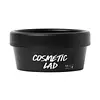What's inside
What's inside
 Key Ingredients
Key Ingredients

No key ingredients
 Benefits
Benefits

 Concerns
Concerns

 Ingredients Side-by-side
Ingredients Side-by-side

Lavandula Angustifolia Water
MaskingLinum Usitatissimum Seed Flour
AbrasivePrunus Amygdalus Dulcis Oil
Skin ConditioningAloe Barbadensis Leaf Juice
Skin ConditioningChamomilla Recutita Flower Extract
MaskingTheobroma Cacao Seed Butter
EmollientStearic Acid
CleansingTriticum Vulgare Germ
BleachingGlycerin
HumectantCetearyl Alcohol
EmollientButyrospermum Parkii Butter
Skin ConditioningMink Oil
Skin ConditioningCitrus Reticulata Fruit
Skin ConditioningSantalum Album Oil
MaskingTriethanolamine
BufferingLimonene
PerfumingLinalool
PerfumingParfum
MaskingMethylparaben
PreservativePropylparaben
PreservativeLavandula Angustifolia Water, Linum Usitatissimum Seed Flour, Prunus Amygdalus Dulcis Oil, Aloe Barbadensis Leaf Juice, Chamomilla Recutita Flower Extract, Theobroma Cacao Seed Butter, Stearic Acid, Triticum Vulgare Germ, Glycerin, Cetearyl Alcohol, Butyrospermum Parkii Butter, Mink Oil, Citrus Reticulata Fruit, Santalum Album Oil, Triethanolamine, Limonene, Linalool, Parfum, Methylparaben, Propylparaben
Astrocaryum Murumuru Seed Butter
EmollientCalcite Powder
Theobroma Grandiflorum Seed Butter
Skin ConditioningRosa Centifolia Flower Extract
AstringentPrunus Amygdalus Dulcis Oil
Skin ConditioningParfum
MaskingAgaricus Bisporus Extract
Skin ConditioningChamomilla Recutita Oil
MaskingRosa Damascena Flower Oil
MaskingMink Oil
Skin ConditioningBenzyl Benzoate
AntimicrobialBenzyl Cinnamate
PerfumingCitral
PerfumingCitronellol
PerfumingFarnesol
PerfumingGeraniol
PerfumingLimonene
PerfumingLinalool
PerfumingAstrocaryum Murumuru Seed Butter, Calcite Powder, Theobroma Grandiflorum Seed Butter, Rosa Centifolia Flower Extract, Prunus Amygdalus Dulcis Oil, Parfum, Agaricus Bisporus Extract, Chamomilla Recutita Oil, Rosa Damascena Flower Oil, Mink Oil, Benzyl Benzoate, Benzyl Cinnamate, Citral, Citronellol, Farnesol, Geraniol, Limonene, Linalool
 Reviews
Reviews

Ingredients Explained
These ingredients are found in both products.
Ingredients higher up in an ingredient list are typically present in a larger amount.
Limonene is a fragrance that adds scent and taste to a formulation.
It's found in the peel oil of citrus fruits and other plants such as lavender and eucalyptus. The scent of limonene is generally described as "sweet citrus".
Limonene acts as an antioxidant, meaning it helps neutralize free radicals.
When exposed to air, oxidized limonene may sensitize the skin. Because of this, limonene is often avoided by people with sensitive skin.
The term 'fragrance' is not regulated in many countries. In many cases, it is up to the brand to define this term. For instance, many brands choose to label themselves as "fragrance-free" because they are not using synthetic fragrances. However, their products may still contain ingredients such as essential oils that are considered a fragrance.
Learn more about LimoneneLinalool is a fragrance and helps add scent to products. It's derived from common plants such as cinnamon, mint, citrus, and lavender.
Like Limonene, this ingredient oxidizes when exposed to air. Oxidized linalool can cause allergies and skin sensitivity.
This ingredient has a scent that is floral, spicy tropical, and citrus-like.
Learn more about LinaloolMink Oil comes from the fat of mink pelts. It is rich in palmitoleic acid, a fatty acid derived from palmitic acid.
Palmitoleic acid has been shown to help soothe inflammation and promote wound healing. It is naturally found in the fat of our skin.
Milk oil, like other oils, is an emollient and prevents moisture loss by creating a barrier on the skin.
Macadamia oil and seabuckthorn oil are alternative oils with similar high palmitoleic acid content.
Learn more about Mink OilParfum is a catch-all term for an ingredient or more that is used to give a scent to products.
Also called "fragrance", this ingredient can be a blend of hundreds of chemicals or plant oils. This means every product with "fragrance" or "parfum" in the ingredients list is a different mixture.
For instance, Habanolide is a proprietary trade name for a specific aroma chemical. When used as a fragrance ingredient in cosmetics, most aroma chemicals fall under the broad labeling category of “FRAGRANCE” or “PARFUM” according to EU and US regulations.
The term 'parfum' or 'fragrance' is not regulated in many countries. In many cases, it is up to the brand to define this term.
For instance, many brands choose to label themselves as "fragrance-free" because they are not using synthetic fragrances. However, their products may still contain ingredients such as essential oils that are considered a fragrance by INCI standards.
One example is Calendula flower extract. Calendula is an essential oil that still imparts a scent or 'fragrance'.
Depending on the blend, the ingredients in the mixture can cause allergies and sensitivities on the skin. Some ingredients that are known EU allergens include linalool and citronellol.
Parfum can also be used to mask or cover an unpleasant scent.
The bottom line is: not all fragrances/parfum/ingredients are created equally. If you are worried about fragrances, we recommend taking a closer look at an ingredient. And of course, we always recommend speaking with a professional.
Learn more about ParfumPrunus Amygdalus Dulcis Oil comes from the sweet almond, a tree native to Iran. This oil has no fragrance and is non-volatile.
Almonds contain healthy fats, vitamins, and minerals. It is a rich source of Vitamin E, a great antioxidant and skin conditioning ingredient. Sweet almond oil contains fatty acids such as linolenic acid and triglycerides.
The content of sweet almond oil makes it a great emollient; it can help soften and hydrate your skin. Emollients create a barrier over your skin to trap moisture in. Sweet almond oil has antioxidant properties.
Those with an almond allergy should be careful of this ingredient and speak with a professional about using it in your skincare.
This ingredient may not be fungal-acne safe.
Learn more about Prunus Amygdalus Dulcis Oil